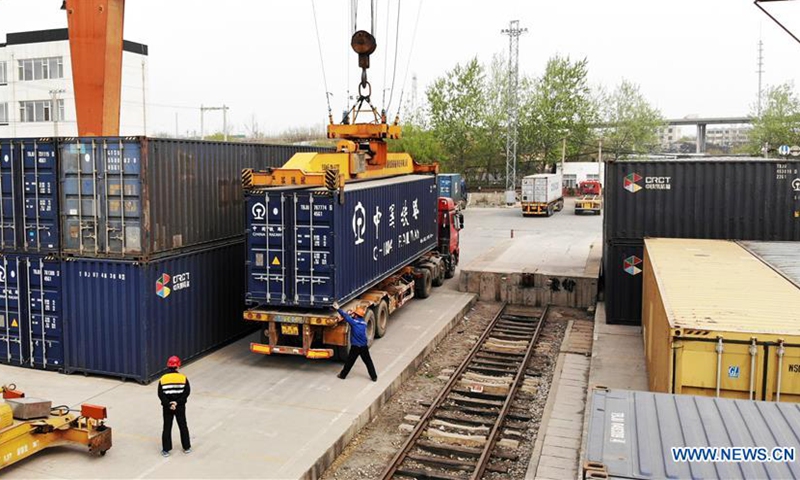SOURCE / INDUSTRIES
Chinese freight transport seeing recovery, but private freight firms still need support

Aerial photo taken on March 24, 2020 shows staff members transport cargo by a crane at Luokou freight station in Jinan, capital of east China's Shandong Province. The freight station of China Railway Jinan Group Co., Ltd has transported 14,409 tons of supplies in the last three months, including 378 tons of food and medical materials to Hubei Province, helping the full resumption of work and production across China. (Xinhua/Wang Kai)
The global cargo industry has been hit by the coronavirus epidemic, as some airlines shut down their services during the outbreak, but the Chinese cargo market has getting back to normal as more cities have started to resume work.
Data from aviation data provider VariFlight shows that Chinese cargo transport has witnessed an increase and reached an even higher peak than last year.
The daily utilization rate of China Cargo Airlines from March 16 to 22 was 11.6 hours per day, the highest utilization rate for Chinese mainland cargo airlines, which was 20 percent higher than in December last year (9.6 hours per day), according to data sent to the Global Times on Wednesday.
Another leading cargo firm SF Express saw a daily utilization rate of 3.7 hours per day, which is 23 percent higher than that of December last year. The daily utilization rate of YTO Express cargo aircraft was 2.6 hours per day, 21 percent higher than last December.
In comparison, during the week of March 16 to 22, FedEx's planes were available for 6.5 hours a day, down 5 percent from December last year and UPS planes were only available for 4.3 hours, a significant decrease of 16 percent from December last year.
"Compared with international markets, China's demand for freight is getting stronger, and it also shows the economy is rapidly recovering," Zheng Hongfeng, CEO of VariFlight, told the Global Times, adding that the total number of cargo flights from some airports in southern cities accounted for 20 percent of total flights.
China Southern plans to add 21 freight flights from Guangzhou and Shanghai to Europe and the US, as well as 19 flights from Guangzhou to Osaka, Ho Chi Minh, and Hanoi, and 19 flights from Pudong to Osaka, Ho Chi Minh, and Hanoi. In March, China Southern 's international cargo flights will reach over 250, according to a note sent to the Global Times.
SF Express said it had quickly deployed up to 13 international routes since February 13, including two charter international routes, and in the next two months it will continue to integrate its 58 all-cargo aircraft and charter aircraft models to open more international routes, the company told the Global Times on Wednesday.
At present, SF operates 20 shifts per week, with a total of 5,872 tons of imported and exported cargo per week.
However, Lin Zhijie, a veteran market watcher, said China's freighter capacity for all-cargo aircraft still has a large gap compared with European and American countries. For example, FedEx has 459 all-cargo aircraft, followed by UPS with 268 cargo aircraft, while China has only 173 cargo aircraft.
The industry should further liberalize flight schedules during the day and support a 24-hour transit model for freight, Zheng said.
On Tuesday, the government said it will support carriers to increase international cargo flight capacity and stabilize supply chains, and will encourage air cargo firms and logistics companies to jointly restructure.


